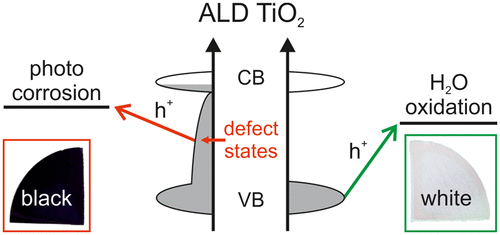当前位置:
X-MOL 学术
›
ACS Appl. Mater. Interfaces
›
论文详情
Our official English website, www.x-mol.net, welcomes your
feedback! (Note: you will need to create a separate account there.)
Diversity of TiO2: Controlling the Molecular and Electronic Structure of Atomic-Layer-Deposited Black TiO2
ACS Applied Materials & Interfaces ( IF 8.3 ) Pub Date : 2019-01-04 00:00:00 , DOI: 10.1021/acsami.8b20608 Harri Ali-Löytty , Markku Hannula , Jesse Saari , Lauri Palmolahti , Bela D. Bhuskute , Riina Ulkuniemi , Tuomo Nyyssönen , Kimmo Lahtonen , Mika Valden
ACS Applied Materials & Interfaces ( IF 8.3 ) Pub Date : 2019-01-04 00:00:00 , DOI: 10.1021/acsami.8b20608 Harri Ali-Löytty , Markku Hannula , Jesse Saari , Lauri Palmolahti , Bela D. Bhuskute , Riina Ulkuniemi , Tuomo Nyyssönen , Kimmo Lahtonen , Mika Valden

|
Visually black, electrically leaky, amorphous titania (am-TiO2) thin films were grown by atomic layer deposition (ALD) for photocatalytic applications. Broad spectral absorbance in the visible range and exceptional conductivity are attributed to trapped Ti3+ in the film. Oxidation of Ti3+ upon heat treatment leads to a drop in conductivity, a color change from black to white, and crystallization of am-TiO2. ALD-grown black TiO2, without any heat treatment, is subject to dissolution in alkaline photoelectrochemical conditions. The best photocatalytic activity for solar water splitting is obtained for completely crystalline white TiO2.
中文翻译:

TiO 2的多样性:控制原子层沉积黑色TiO 2的分子和电子结构
通过原子层沉积(ALD)生长视觉上呈黑色,漏电的非晶态二氧化钛(am-TiO 2)薄膜,以进行光催化应用。可见光范围内的宽光谱吸收和出色的电导率归因于薄膜中捕获的Ti 3+。热处理时Ti 3+的氧化导致电导率下降,颜色从黑色变为白色以及am-TiO 2结晶。ALD生长的黑色TiO 2未经任何热处理,在碱性光电化学条件下会溶解。对于完全结晶的白色TiO 2,获得了最佳的太阳能水分解光催化活性。
更新日期:2019-01-04
中文翻译:

TiO 2的多样性:控制原子层沉积黑色TiO 2的分子和电子结构
通过原子层沉积(ALD)生长视觉上呈黑色,漏电的非晶态二氧化钛(am-TiO 2)薄膜,以进行光催化应用。可见光范围内的宽光谱吸收和出色的电导率归因于薄膜中捕获的Ti 3+。热处理时Ti 3+的氧化导致电导率下降,颜色从黑色变为白色以及am-TiO 2结晶。ALD生长的黑色TiO 2未经任何热处理,在碱性光电化学条件下会溶解。对于完全结晶的白色TiO 2,获得了最佳的太阳能水分解光催化活性。




















































 京公网安备 11010802027423号
京公网安备 11010802027423号